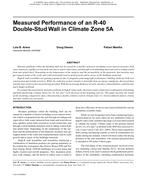Description
Moisture problems within the building shell can be caused by a number of factors including excess interior moisture, bulk water intrusion, capillary action from concrete to wood connections, and through wetted building materials such as siding wetted from rain splash back. Depending on the temperature of the surfaces and the permeability of the materials, that moisture may get trapped inside of the walls and could potentially lead to mold growth and/or decay of the buildings materials.
High-R wall assemblies are gaining popularity due to programs promoting high performance building shells for both new construction and retrofit activities. While the reduction in heat transfer is desirable from an energy standpoint, decreased heat transfer also results in decreased drying potential.With the increasing thickness of walls, moisture related failures could become much bigger problems.
To evaluate the potential for moisture problems in high R-value walls, the project team conducted a combination of modeling and field monitoring. Climate Zones 4A, 5A, 6A, and 7 were the focus of the modeling exercise. This paper presents the results of the modeling compared to data collected from a double cellulose wall in Climate Zone 5A. Several different failure criteria and their validity are discussed.
Presented at Thermal Performance of Exterior Envelopes of Whole Buildings XII, December 2013
Citation: Thermal Performance of Exterior Envelopes of Whole Buildings XII
Product Details
- Published:
- 2013
- Number of Pages:
- 12
- File Size:
- 1 file , 5.4 MB
- Product Code(s):
- D-BldConf13-09




